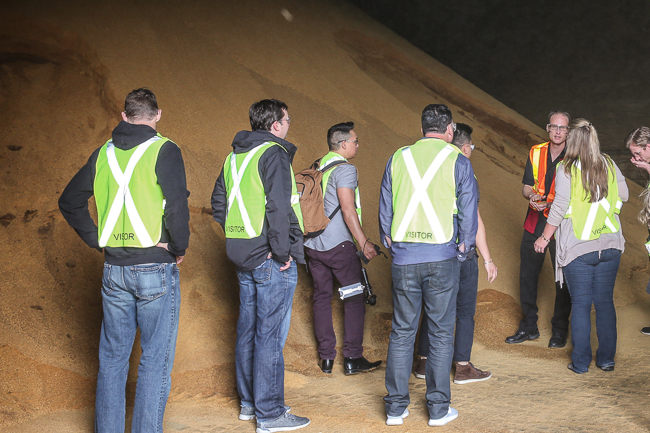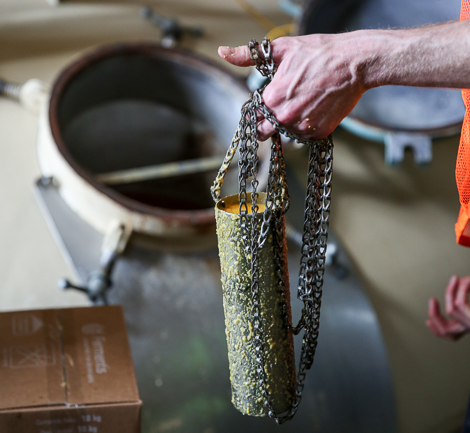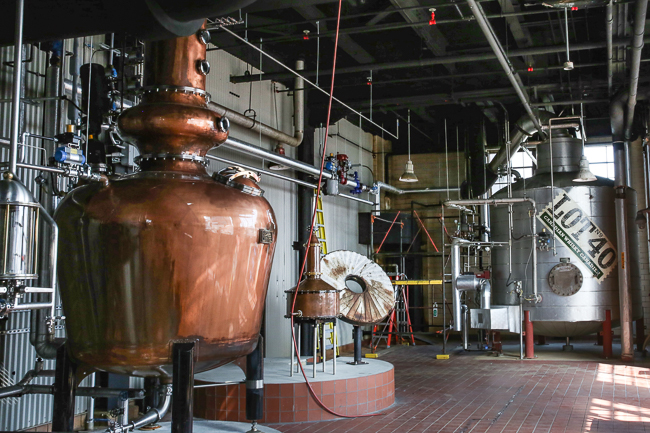North America's Largest Distillery

I'm not sure anything can prepare you for the sheer size and scale of the Hiram Walker distillery in Windsor, a historic whisky center that's been operating in Canada longer than Canada has even been a country. The campus is absolutely gigantic and the volume at this point amounts to more than fifty million liters a year of proof spirit, a decent amount of which is contract work. There's not a major booze player in the U.S. that isn't contracting some amount of whisky from Hiram Walker, as the facility runs the full gambit of grains from barley, to corn, to wheat, to rye, each of which can be distilled individually or as a mash. Canadian whisky, however, is obviously the specialty. It's what built the Hiram Walker distillery into what it is today. According to Don Livermore, the master blender at the site, it was Canadian whisky as a whole that built the infrastructure for the former British colony early on. In 1867, when the provinces were aligned under one self-governing body, there was no income tax levied upon the newly-anointed Canadian citizens. The money needed to build the country's future roads, railways, and government enterprises came from taxes levied on the young nation's largest businesses; companies called Corby, Wiser, and, of course, Hiram Walker—the leading whisky producers of the time.

Hiram Walker today is owned by Pernod-Ricard who still allows Beam-Suntory, the owner of the Canadian Club brand, to produce the widely-known whisky onsite. While we were mainly there in support of HW's fantastic Lot 40 rye whisky, a brand that along with Whistle Pig and Masterson's has helped to change the reputation of Canadian whisky in the states, most of us were definitely interested in understanding the distillery's production methods entirely for a better understanding of the Canadian whisky category. The first observation that just blew my mind was how much grain Hiram Walker is going through on a daily basis. They have a number of gigantic grain silos near the entrance that only hold enough grain to get through a mere three days of operation. Standing next to the mountains of freshly-milled corn, the sight was truly jawdropping. The other facet of the HW production I find interesting is that all the grains are stored, milled, fermented, and distilled individually using various methods. You've got single column-distilled spirits (like American Bourbon and rye) and double-column-distilled spirits (distilled to about 94% near-neutral, just a step below vodka, like Scottish grain whisky). Considering the four grains being used, that's eight different whiskies right there. Then add a pot-distilled version of each grain, which bumps up the number of whiskies to twelve. Then add the sour mash formula and various other custom recipes and you begin to understand the flexibility of their operation.

If you're going to mill that much grain, you have to be able to ferment it, right? Where as most major whisky distilleries have maybe two large fermentation tanks, Hiram Walker has a whopping thirty-nine and they're monstrous! They're all stored in the largest fermentation room I've ever laid eyes on where there are a dozen of different beers being made for future distillations. The photo above only captures about a third of the room.

If you need a refresher on what exactly constitutes Canadian whisky, I'll give you the quick version. Take pretty much everything you know about Scotch and combine it with some facets of American whiskey. Canadian whisky by law is a whisky made from grain in Canada that is at least three years old. It's a pretty loose and basic interpretation of whisky, which is why there's so much potential for variation. Canadian whisky in theory is very much like Scotch whisky, which also has its column-distilled grains and pot-distilled whiskies that can be blended or bottled individually. In the case of Canadian whisky, however, there are simply more blending components to choose from. Unlike Scotch, which uses 100% barley single malt as its blending base (or its entirety), Canadian whisky relies on rye as the flavor foundation. You might see a blend that has 70% column still grain whisky and 30% pot still rye, for example. The kicker is the 1/11th or 9.09% rule that allows producers to add a portion of just about any alcohol that isn't Canadian whisky as a flavor enhancer. Whereas Scotch producers have to age their whiskies in sherry barrels to get that sweet influence, a Canadian whisky producer can literally add sherry right into the vat—up to 9.09%. Or they can add port. Or wine. Or rum. In that case, Canadian whisky offers producers a large amount of freedom. A purist might call that cheating, but I know for a fact that every Scotch and Irish distiller would jump at the chance to pour Oloroso sherry right into their blends were they allowed to!

Remember the thirteen-plus possible whisky types I mentioned above? Get ready to add a few dozen more possible permutations. Much like Scotland, Canadian producers do not have to use new oak barrels like Bourbon distillers do. There is a volume limit, but no standardization as to type (they can't use giant foudres or huge oak vats, for example). So now take your thirteen-plus Hiram Walker recipes and put them in new charred oak, refill oak, and refill Bourbon casks. That's basically three types of potential aging vessel for each style of whisky, not counting sherry-finishing, rum-finishing, virgin oak, etc. You can see where I'm going here. I'd advise you to drive out to Pike's Creek if you visit, the warehousing facility for Hiram-Walker about twenty minutes from the distillery. There you'll find more than 160 football fields...excuse me...ice hockey arenas worth of whisky warehouses, piled to the ceiling with upright, palletized barrels. They drill new bung holes right in the top in Canada and you can forget about dipping in the whisky thief. They have a tap that gets inserted right in the hole to pump out all that amazing juice! We tasted Lot 40 straight out of the barrel at full proof today and it was incredible. I hear there's a limited edition version of this coming out later this Fall. Get your wallets ready.

While Hiram Walker's specialty is still blended Canadian whisky, don't think they're not hip to the accolades being bestowed on the Lot 40 pot-distilled rye. I tasted a number of limited Wiser's editions at the tasting room with higher proofs and higher rye contents. The result was a higher level of excitement from my taste buds. I'm excited to see how their production develops and if it responds to American enthusiasm. There's so much potential for crossover and experimentation here. The sky at Hiram Walker, or in this case Pernod-Ricard's patience, is truly the limit to what they can do. I'm definitely padding my suitcase with a few distillery limited edition bottles later tonight.
-David Driscoll
